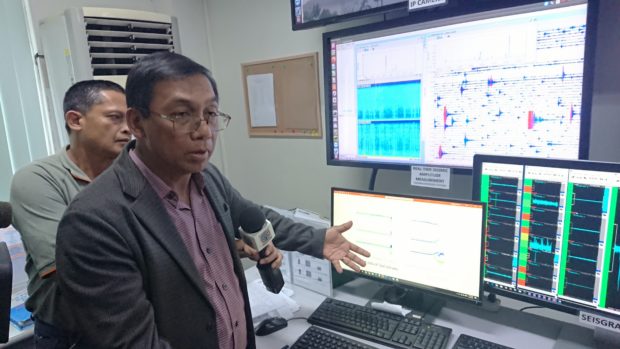Phivolcs defends monitoring capability on Taal Volcano

DOST Usec. and Phivolcs director Renato Solidum Jr. on January 15 showed media the state-of-the-art volcanic and earthquake monitoring systems of Phivolcs.
MANILA, Philippines — Philippine Institute of Volcanology and Seismology (Phivolcs) on Wednesday admitted that some of their monitoring stations on Taal Volcano have been compromised due to its continuing unrest, with only one out of their five stations on Volcano Island remaining operational.
“Hindi po natin alam kung yung ibang station ay sira talaga… Hindi po natin alam kung yung radyo ang sira o yung solar panel (We don’t know if the other stations are completely destroyed. We don’t know if the problem is with radio or the solar panel),” Ma. Antonia Bornas, chief of Phivolcs’ Volcano Monitoring and Eruption Prediction Division, said at a press conference.
Bornas said however that other stations around the lake are still in working order.
“Yung sa paligid po ng lawa, operational po lahat yan. Kailangan lang po linisin yung radyo at solar panel para po makakuha ng power yung ating istasyon para po makadirecho ng transmission sa ating opisina (Those surrounding the lake are all operational. We just need to clean the radio and solar panel so the station can receive power and direct transmission to our office),” she said.
Phivolcs pointed out that this scenario where some stations become unavailable is normal because they were placed near the crater.
Article continues after this advertisementDespite the unavailability of some stations, Phivolcs said it also makes use of the Philippine seismic network which can detect the intense volcanic earthquakes.
Article continues after this advertisement“As of now, near full operationality yung surviving stations natin, pero hindi po tayo ever nabulag sa Taal kasi meron tayong mas malaking Philippine seismic network (As of now, our surviving stations are near full operationality, but we were never in the dark when it comes to Taal because we have a wider Philippine seismic network),” explained Bornas.
The Philippine seismic network is primarily used in monitoring large magnitude earthquakes but it can also detect volcanic earthquakes with high intensity.
In addition, Phivolcs also anticipated the malfunctioning of some stations so they prepared auxiliary stations and seismometers that are ready for deployment.
“Nagtayo po tayo dito sa Tagaytay. Nagsa-scout pa po ang ating team sa field para sa paglalagyan ng mga temporary stations (We’ve put up one in Tagaytay. Our team is still scouting the field for locations for the temporary stations),” she said.
“Challenging” Taal
Despite their state-of-the-art monitoring instruments, the Philippine Institute of Volcanology and Seismology (Phivolcs) found the rapid escalation of Taal’s unrest “challenging.”
“In general, we are not really far behind. We’re actually maybe advanced,” Phivolcs director and Department of Science and Technology Undersecretary Renato Solidum Jr., said, referring to comparisons with neighboring countries’ monitoring systems.
Solidum said that when they started to improve their instruments and monitoring systems decades ago, Phivolcs received assistance from Japanese and Belgian scientists, among others, in acquiring sophisticated instruments.
Among other things, these instruments are used in monitoring the tilting of the volcano due to magma activities, the lakewater’s temperature and acidity level, the horizontal bulging of the volcano, and the amount of carbon dioxide in the lake.
“The initiation of the phreatic activity is one of the most difficult eruptions to watch out for,” Solidum said.
However, he maintained that though the alert level system needs constant reevaluation after every major disaster, the current one is sufficient for now.
“Ang alert level (system) na pinapairal natin, even sa ibang bansa, nakadesign yun sa pinakamatinding eruption (The alert level [system] we have now, even in other countries, is designed for the most explosive eruption),” he said.
On Tuesday, a lawmaker called for an investigation on government agencies, including Phivolcs, in charge of information dissemination amid the Taal eruption.
Cavite Rep. Elpidio Barzaga claimed that Phivolcs has limited “technical expertise to make a timely forecast of the Taal Volcano eruption” and questioned the agency’s “comprehensive monitoring.”